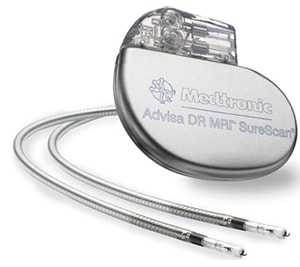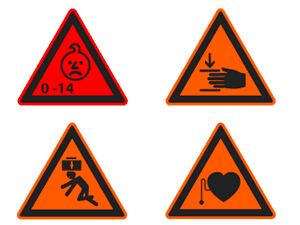Magnets and pacemaker
 In the safety instructions that we attach to each order, it is written:
In the safety instructions that we attach to each order, it is written:
If you wear a pacemaker or defibrillator, keep a sufficient distance away from magnets. Warn wearers of these devices against approaching magnets.
The term “sufficient distance” is very vague, so naturally customers turn to us with the question of what distance from magnets is still safe for pacemaker wearers. In this article we will try to provide at least an approximate answer.
Safe magnetic field
In its article on the effect of MP3 players on pacemakers, Boston Scientific, a major pacemaker manufacturer, lists 10 Gauss (1m Tesla) as a safe magnetic field:
“As stated in the instructions for the use of pacemakers and defibrillators, a magnetic field stronger than 10 Gauss may affect the function of the implanted device.”

The American Heart Association also mentions 10 Gauss as a critical threshold:
“A magnetic field of 10 Gauss at the point where a pacemaker or defibrillator is placed has the potential to affect an implanted device.”
Another (paid for) article by the Biomedical Institute of the University of Zurich also gives a value of 10 Gauss.
Pacemaker manufacturer Medtronic lists a safe magnetic field of only 5 Gauss.
How far does the magnet have to be?
Let’s expect a smaller value of 5 Gauss to be sure.
Larger magnets naturally create a stronger magnetic field, so the safe distance depends on the size of the magnet. You can also calculate the magnetic field that a magnet creates on its surface using our magnetic calculator, just enter the dimensions and shape of the magnet.
After entering even very small dimensions, you will find that the neodymium magnets on their surface create a field significantly stronger than 5 Gauss. So if you were to place any magnet directly over the implanted device, it would probably have a significant effect on it.
However, the magnetic field around a permanent magnet decreases sharply with distance. In this table you will find the distances at which our magnets create a magnetic field of 20 Gauss, 5 Gauss and 1 Gauss.
If we follow the value of 5 Gauss from Meditronic, the safe distances are in the middle column.
| Magnet | 20 Gauss | 5 Gauss | 1 Gauss |
|---|---|---|---|
| Disc, 2×1 | 6 mm | 10 mm | 18 mm |
| Disc, 10×2 | 25 mm | 40 mm | 70 mm |
| Disc, 15×5 | 43 mm | 70 mm | 120 mm |
| Disc, 20×10 | 65 mm | 105 mm | 180 mm |
| Disc, 20×10 | 65 mm | 105 mm | 180 mm |
| Cube 10x10x10 | 43 mm | 70 mm | 120 mm |
| Cube 30x30x30 | 140 mm | 225 mm | 390 mm |
| Block 20x10x5 | 45 mm | 70 mm | 125 mm |
| Block 60x30x15 | 130 mm | 220 mm | 370 mm |
| Block 40x40x20 | 140 mm | 220 mm | 400 mm |
However, these calculations are based on the assumption that 5 Gauss is a safe distance, which may not be true for all pacemakers.
What happens if the magnet is too close?
The implanted device can mistakenly perceive electromagnetic field signals as heart signals. As a result, it may suspend stimulation. A common effect is a feeling of nausea.
After the magnet is removed, the pacemaker’s action usually returns to its original state.
Summary
The often-mentioned safe magnetic field intensity is 5-10 Gauss. With such a value, a safe distance is approximately 10 cm for magnets under 20 mm and 25 cm for larger magnets. However, these numbers may not apply to all pacemakers.
If you have an implanted pacemaker or defibrillator, be sure not to carry the magnet in your chest pocket. Also, you should not wear headphones near your chest (they usually contain magnets). If you have headphones in your ears, do not rest your head on the chest of a person with an implanted heart device.


